Exploring Funding Gaps and Possibilities in Lung Cancer Research Funding
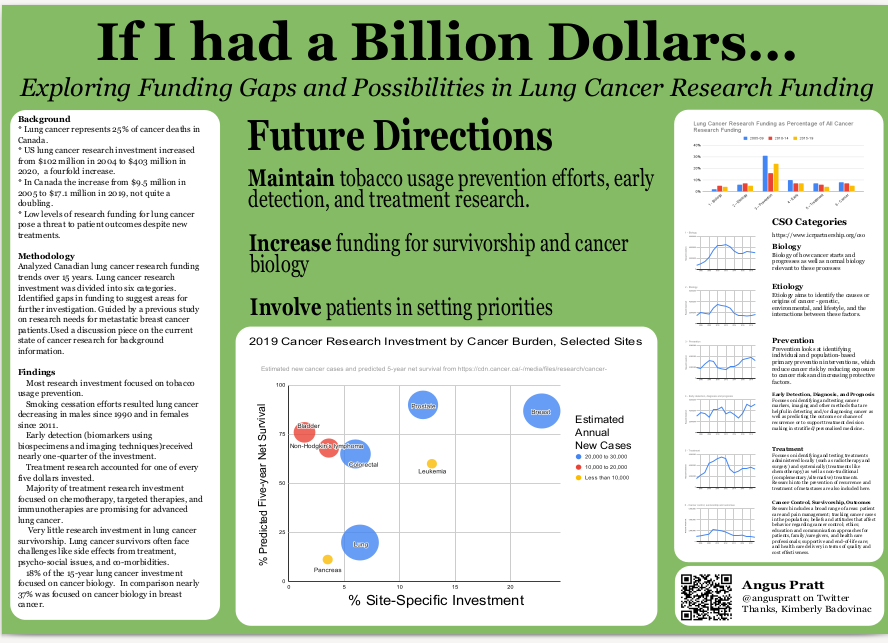
Background
Lung cancer is one of the most lethal cancers, with a five-year survival rate of only 19%. Despite this, research investment in lung cancer has historically been significantly lower than that of other cancers. However, the past 15 years have seen an increase in funding for lung cancer research. A recent analysis of the American National Cancer Institute's (NCI) Cancer Research Portfolio (CRP) showed that the investment in lung cancer research increased from $102 million in 2004 to $403 million in 2020, with an average annual growth rate of 6.8%. 1
Research in Canada has not kept pace. Looking at 5 year cohorts from 2005 to 2009, $71 million was spent. In 2010 to 2014, $95 million was spent. From 2015 to 2019, $84 million was spent. In Canada the increase from $9.5 million in 2005 to $17.1 million in 2019, not quite a doubling.
Predictions show that 20,700 Canadians will die from lung cancer. This represents 24% of all cancer deaths in 2022. 30,000 Canadians will be diagnosed with lung cancer. This represents 13% of all new cancer cases in 2022. It is estimated that about 1 in 15 Canadian men will develop lung cancer during their lifetime, and 1 in 18 will die from it. It is estimated that about 1 in 15 Canadian women will develop lung cancer during their lifetime and 1 in 20 will die from it. 4
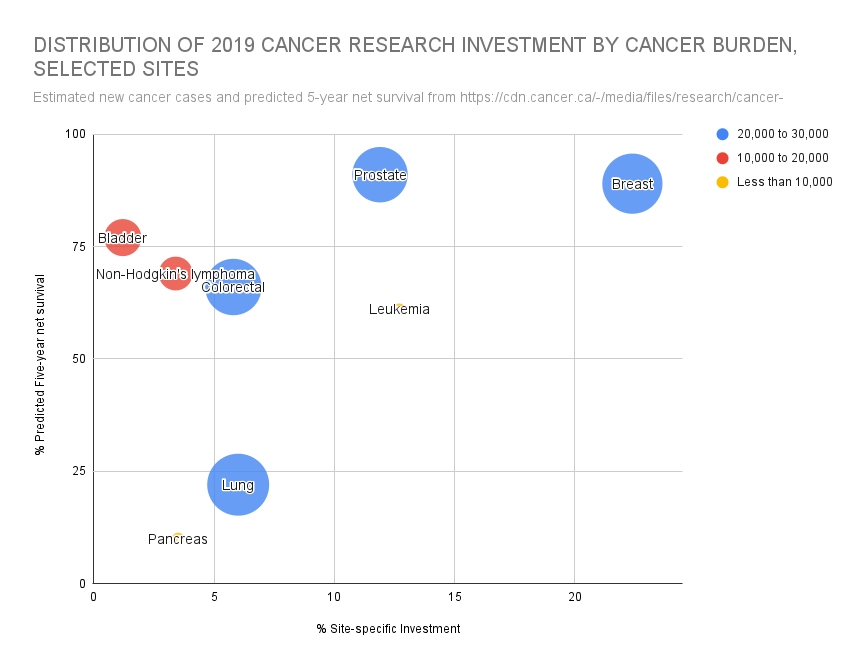
25% of cancer deaths in Canada result from lung cancer, but the research funding for lung cancer in 2019 was $18 million. In sharp contrast, breast cancer, being diagnosed at nearly the same rate as lung cancer each year, accounts for about 6% of cancer deaths, but $66 million of research funding in 2019.
With new treatments, lung cancer patients are living longer Although new treatments are helping lung cancer patients live longer, low levels of research funding continue to pose a threat to the lung cancer patient community.
Strategic research investment in other cancers (notably breast cancer) has dramatically increased survival rates and improved prognoses. However, funding programs directed at lung cancer research have been far and few between. In the lung cancer patient community, low levels of research funding are well-documented. Research funding that is proportional to the burden of disease may indeed improve outcomes for lung cancer patients.
Methodology
The purposes of this poster are:
a) Identify trends in lung cancer research funding from the past 15 years.
b) Identify gaps in lung cancer research funding to suggest profitable areas for further investigation.
A recent article on identifying need for research for MBC (metastatic breast cancer) patients guided the initial analysis of this paper. 2 A discussion piece in CA: A Cancer Journal for Clinical Oncologists, titled, "Blueprint for Cancer Research: Critical Gaps and Opportunities" was used to provide general background on the current state of cancer research. 3
Findings
Using data from the Canadian Cancer Research Alliance (CCRA), the breakdown of research funding in Canada using the Common Scientific Outline (CSO) was examined for lung cancer research compared to all site-specific cancer research funding for a 15-year period (2005 to 2019). These data are helpful in identifying potential gaps and areas where additional funding could be effectively used.
| 1 - Biology | Biology of how cancer starts and progresses as well as normal biology relevant to these processes |
| 2 - Etiology | Etiology aims to identify the causes or origins of cancer - genetic, environmental, and lifestyle, and the interactions between these factors. |
| 3 - Prevention | Prevention looks at identifying individual and population-based primary prevention interventions, which reduce cancer risk by reducing exposure to cancer risks and increasing protective factors. |
| 4 - Early Detection, Diagnosis, and Prognosis | Early Detection, Diagnosis, and Prognosis focuses on identifying and testing cancer markers, imaging and other methods that are helpful in detecting and/or diagnosing cancer as well as predicting the outcome or chance of recurrence or to support treatment decision making in stratified/personalised medicine. |
| 5 - Treatment | Treatment focuses on identifying and testing treatments administered locally (such as radiotherapy and surgery) and systemically (treatments like chemotherapy which are administered throughout the body) as well as non-traditional (complementary/alternative) treatments (such as supplements, herbs). Research into the prevention of recurrence and treatment of metastases are also included here. |
| 6 - Cancer Control, Survivorship, and Outcomes Research | Cancer Control, Survivorship, and Outcomes Research includes a broad range of areas: patient care and pain management; tracking cancer cases in the population; beliefs and attitudes that affect behavior regarding cancer control; ethics; education and communication approaches for patients, family/caregivers, and health care professionals; supportive and end-of-life care; and health care delivery in terms of quality and cost effectiveness. |

When examining the six categories of the Cancer Research Portfolio's CSO for lung cancer research investment, several trends were noted. Firstly, much of the research investment focused on tobacco usage prevention efforts. This is not surprising since tobacco smoking is the leading cause of lung cancer. Prevention efforts (advertising, taxes, education) focused on reducing tobacco use. Smoking cessation efforts aimed to help current smokers quit. These efforts have been successful. The Canadian Cancer Society reports that:
“ In males, the incidence rate for lung cancer was stable in the late 1980s and has been decreasing since 1990, though at different rates: steeply from 1990 to 2003 (-2.2%), then less steeply from 2003 to 2011 (-0.9%), and then more steeply after 2011(-3.3%). In females, the lung cancer incidence rate increased significantly between 1984 and 1993 (2.9%). The increase continued, but more slowly, from 1993 to 2011 (0.9%). Starting in 2011 the lung cancer incidence rate in females started to decrease (-1.3%).” 3
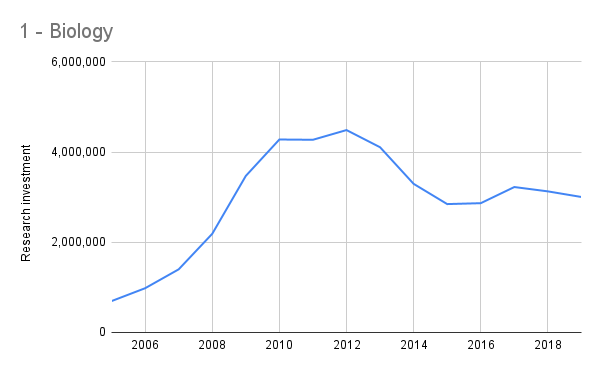 |
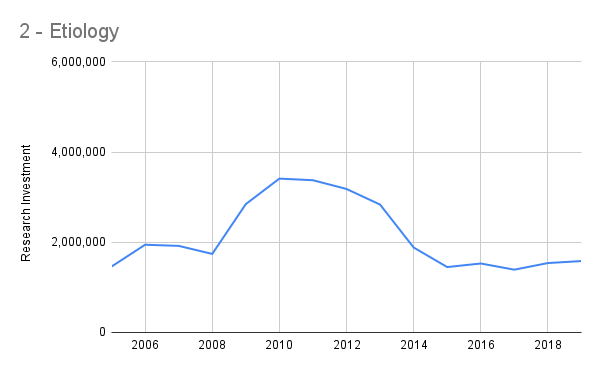 |
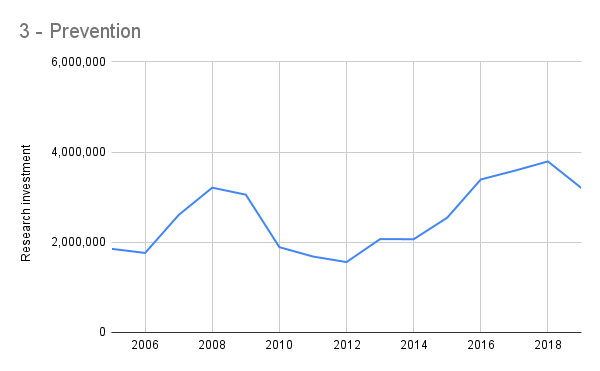 |
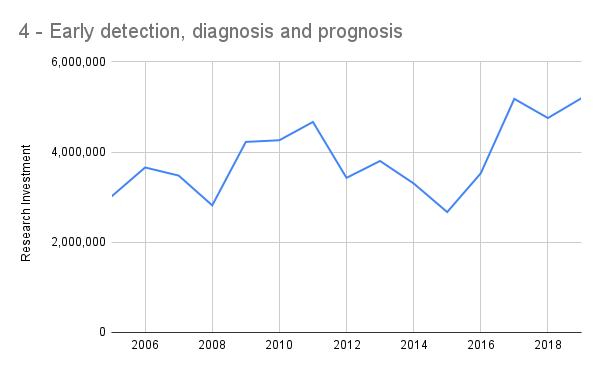 |
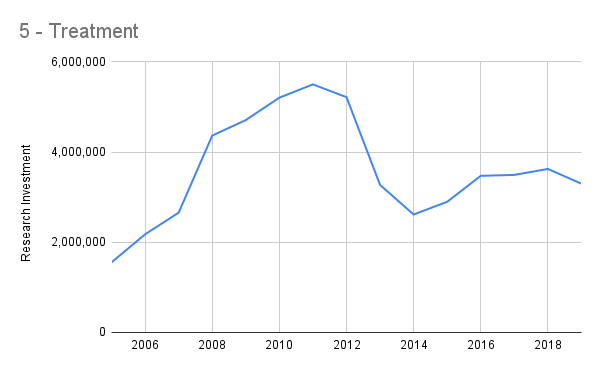 |
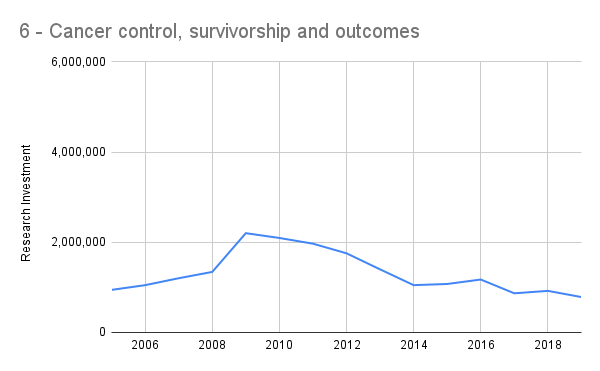 |
Another notable trend was that nearly one-quarter of the investment was focused on early detection. Early detection is crucial for improving lung cancer survival rates, as the disease is often asymptomatic until it has reached an advanced stage. The focus of early detection research was primarily on the discovery of biomarkers using biospecimens and imaging techniques. This is an area of research that has shown promise, as evidenced by the recent approval of liquid biopsy tests for lung cancer diagnosis.
Treatment research accounted for one of every five dollars invested in lung cancer research over a 15-year period. The majority of the research investment was focused on chemotherapy and targeted therapies, with more recent investments in immunotherapies, which have shown promise in the treatment of lung cancer. Immunotherapies, such as checkpoint inhibitors, work by stimulating the body's immune system to recognize and attack cancer cells. This approach has shown significant benefits in lung cancer patients, particularly those with advanced-stage disease.
Despite the growing number of lung cancer survivors, there was very little research investment on cancer survivorship. This is an area where more research is needed, as lung cancer survivors often face a multitude of challenges, including side effects from treatment, psychosocial issues, and comorbidities.
Finally, 18% of the 15-year lung cancer research investment focused on cancer biology. This was dramatically different from the distribution of breast cancer research investment, where nearly 37% was focused on cancer biology. This disparity may be due to the fact that breast cancer is a more common cancer and has a larger patient population, which translates into more research funding.
Future Directions
In conclusion, lung cancer research investment has increased over the past 15 years, with a focus on tobacco usage prevention efforts, early detection, and treatment research. While these areas are important, more research is needed in survivorship and cancer biology. As lung cancer remains a major public health challenge, continued investment in lung cancer research is critical to improving outcomes for patients with this disease.
In tandem with this data, next steps include investigating what the scientific literature identifies as promising areas of research; and exploring the possibility of initiating a research priority-setting process using a James Lind Alliance approach or similar methodology. With a slate of research priorities, lung cancer research advocates will be able to craft persuasive arguments to research funders for increased investment in lung cancer research.
Citations
- National Cancer Institute Funding for Research Areas. https://www.cancer.gov/about-nci/budget/fact-book/data/research-funding (accessed March 30, 2023)
- Heather Douglas, Kimberly Badovinac, and Nancy A. Nixon :"What do we mean when we ask for more metastatic breast cancer research?" - Poster presented at CCRA 2021
- Elmore LW, Greer SF, Daniels EC, et al. Blueprint for cancer research: Critical gaps and opportunities. CA Cancer J Clin. 2021;71(2):107-139. doi:10.3322/caac.21652
- Canadian Cancer Statistics - 2019. https://cdn.cancer.ca/-/media/files/research/cancer-statistics/2019-sta… p 19. ((accessed March 30, 2023)Downloadable